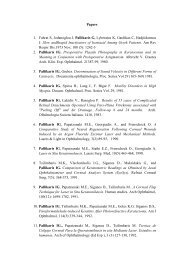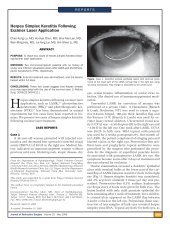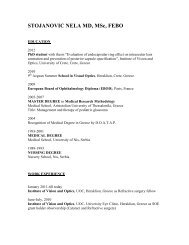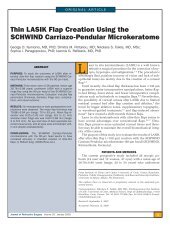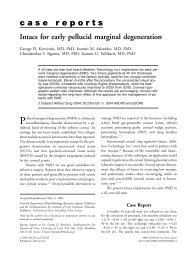Placido Disk
Placido Disk
Placido Disk
Create successful ePaper yourself
Turn your PDF publications into a flip-book with our unique Google optimized e-Paper software.
<strong>Placido</strong> <strong>Disk</strong><br />
Γεώργιος Κουνής – Απρ. 2005<br />
History of Corneal Topography<br />
History<br />
Motivation<br />
Curiosity<br />
1619 Scheiner<br />
Convex mirrors<br />
Techniques<br />
Spheres<br />
1854 Von Helmoltzc<br />
Measurements<br />
Diameter<br />
Contact Lenses<br />
Graft, incisional and<br />
cataract surgery<br />
Excimer Surgery<br />
1882 <strong>Placido</strong><br />
<strong>Placido</strong> Disc<br />
Keratometry<br />
Videokeratoscopy<br />
1889 Javal <strong>Placido</strong><br />
Disc & Kertatometer<br />
1896 Gullstrand<br />
Photography&Kertatometer<br />
Projection Techniques<br />
Curvature<br />
Power<br />
Height/True Shape
Corneal Topography principles<br />
• Videokeratography (Corneal Topography)<br />
A type of computerized imaging technology<br />
• Purpose very detailed description of the<br />
shape and power of the cornea<br />
• Surface description topographical relief<br />
maps of earth<br />
Corneal Topography principles<br />
• Multiple light concentric rings are<br />
projected on the cornea.<br />
• The reflected image is captured on<br />
charge-coupled device (CCD) camera.<br />
• Computer software analyzes the data and<br />
displays the results in a variety of formats
Methods<br />
Small Cone<br />
Color Coded Map<br />
ANGLE<br />
RING<br />
DISTANCE<br />
RoC<br />
0<br />
1<br />
311<br />
10320<br />
Large Cone<br />
Computer<br />
Unit<br />
0<br />
…<br />
0<br />
1<br />
2<br />
…<br />
30<br />
1<br />
381<br />
…<br />
4182<br />
312<br />
10320<br />
…<br />
8880<br />
10320<br />
1<br />
2<br />
384<br />
10330<br />
…<br />
…<br />
…<br />
…<br />
1<br />
30<br />
4184<br />
8890<br />
…<br />
…<br />
…<br />
359<br />
1<br />
311<br />
10320<br />
…<br />
…<br />
…<br />
…<br />
359<br />
30<br />
4185<br />
8880<br />
Topographic results as exported in<br />
ASCII raw data file.<br />
Categories of Videokeratographers<br />
• 2 General Categories<br />
◦Curvature based systems<br />
•Systems that employ a large<br />
placido disk which is several inches<br />
in diameter and is positioned<br />
several inches from the patient's<br />
eye where the imaging is performed<br />
•Systems that employ small placido<br />
cone disk that fit very close to the<br />
eye when the imaging is performed.
Categories of Videokeratographers –<br />
Curvature based systems<br />
• Using basic optical principles, an object of<br />
known size reflected off of a mirror of known<br />
power will produce an image of known size.<br />
• In videokeratography, we know<br />
◦the size of the circular object that is being reflected off of<br />
the cornea<br />
◦We observe the image of this reflected circle by simply<br />
taking a picture of it.<br />
◦The next trick is to determine the power (shape) of the<br />
reflecting surface (the cornea).<br />
Categories of Videokeratographers<br />
•Elevation based systems<br />
◦Orbscan, manufactured by Orbtek,<br />
acquires data from the diffuse reflection of<br />
a slit beam of light scanned across the<br />
cornea.
Categories of Videokeratographers<br />
• Elevation based systems<br />
◦Optical Interferometry<br />
based Videokeratography<br />
•Devices with a sinusoidal<br />
grading is reflected from<br />
the surface of the cornea.<br />
From this data, the<br />
principle of interferometry<br />
is used to localize the<br />
outer surface of the eye.<br />
Corneal Topography Principles<br />
• Keratometric diopter from radii of curvature as :<br />
K = 1 - 1.3375 / RoC(m).<br />
• The simplification ignoring<br />
◦The refracting surface is air-tear interface<br />
◦Not accounting the oblique incidence of incoming light in<br />
the corneal periphery<br />
• Miscalculation true corneal refractive index of 1.376 to<br />
1.3375 to correct for some of these factors.<br />
• These are keratometric diopters to distinguish from<br />
diopters expressing more precisely the true refractive<br />
power at certain corneal point.
Corneal Topography Principles<br />
Inaccuracies generated by conversion of curvature to<br />
power (SKI=Standard Keratometric Index)<br />
Assumptions made in converting<br />
ROC to power<br />
Conversion formula Spherical optics<br />
Effects<br />
Inaccurate outside the central cornea<br />
SKI Normal posterior curvature<br />
SKI Normal thickness cornea<br />
SKI Uniform cornea refractive index &<br />
Not recognize of different refractive<br />
properties of epithelium and stroma<br />
Inaccurate for very steep or very flat<br />
corneas(High myopia or high<br />
Hyperopia)<br />
Inaccurate following excimer laser<br />
photorefractive keratectomy<br />
Inaccurate in situation as following<br />
refractive surgery<br />
Comparison of three cornea topographic devices<br />
Instruments<br />
Keratometer<br />
Photokeratoscope<br />
Computer<br />
videokeratoscope<br />
Examples<br />
Von Helmoltz,<br />
Javal-Schiotz<br />
Corneascope<br />
TMS, Eye-Sys<br />
Number of points<br />
4<br />
Many<br />
6000-11000<br />
Area<br />
Annulus of 3 mm radius<br />
70% surface<br />
95% of surface 9-11mm<br />
diameter<br />
Dioptric Range<br />
30-60 D<br />
infinite<br />
8-110 D<br />
Focusing<br />
Superimposition/alignment<br />
of two mires(easy)<br />
Subjective focusing of single<br />
image (difficult)<br />
Overlap laser or<br />
croshairs(easy)<br />
Mires<br />
Four objects<br />
12 rings<br />
15-38 rings<br />
Record<br />
Two numbers<br />
Still photography<br />
Stills from video<br />
Method<br />
Measurement<br />
Observation<br />
Quantitative<br />
Topographic information<br />
None<br />
Quantitative<br />
Quantitative<br />
Accuracy<br />
Excellent(for spheres)<br />
Poor<br />
Good<br />
Sensitivity<br />
Moderate<br />
Low(3DC)<br />
0.25 D or better<br />
Reproducibility<br />
Excellent<br />
Moderate<br />
Good(0.5D)
Various types of topographic representations<br />
Standard/Normalized scale/Diopter Map – Rings over the cornea –<br />
Lost measurements<br />
Superimposition of of the color map shows how the topography<br />
relates to the whole cornea or focal irregularities
Color encoding<br />
Scales II<br />
• Normalized maps have<br />
different color scales<br />
assigned to each map based<br />
on the instrument software<br />
that identifies the actual<br />
minimal and maximal<br />
keratometric dioptric value of<br />
a particular cornea.<br />
◦ The disadvantage is that the<br />
colors of 2 different maps<br />
cannot be compared directly<br />
and have to be interpreted<br />
based on the keratometric<br />
values from their different<br />
color scales.<br />
Based upon the distribution<br />
of corneal curvatures within<br />
the population. Steepest<br />
areas are depicted in<br />
warmer colours and flattest<br />
areas in cooler colours.<br />
Population<br />
+3SD<br />
+1SD<br />
Mean<br />
-1SD<br />
-3SD<br />
Slope<br />
Steep<br />
Average<br />
Flat<br />
Curvature(<br />
mm)<br />
7.0<br />
7.5<br />
7.8<br />
8.0<br />
8.7<br />
Power<br />
(D)<br />
48.0<br />
45.0<br />
43.5<br />
42.0<br />
39.0<br />
Color<br />
Red<br />
Orange/y<br />
ellow<br />
Yellow/G<br />
reen<br />
Green/<br />
Light<br />
Blue<br />
Blue<br />
Various types of topographic representations<br />
Standard/Normalized scale/Diopter Map
Various types of topographic representations<br />
Standard/Absolute scale/Diopter Map<br />
Myopia
Various types of topographic representations Standard/Normalized scale vs<br />
Absolute Scale/Diopter Map<br />
Mild<br />
Astigmatism<br />
Various types of topographic representations Standard/Normalized<br />
scale/Diopter Map – 3-D representation
Various types of topographic representations Standard/Normalized<br />
scale/Diopter Map – Enchanced Height Map<br />
Ablation profiles - Algorithm Simulation - Spherical<br />
Myopia<br />
With a 6mm OZ No Blend Zone<br />
6.0<br />
DENSITY MAP<br />
SHOT PATTERN<br />
Ablation pattern for low myopia:<br />
-1.00D sphere<br />
6.0mm zone with no blend
Ablation Profiles - Algorithm Simulation - Myopic<br />
Astigmatism<br />
5.5mm circular O.Z. with 1mm blend of flat axis<br />
ablation zone<br />
1.0<br />
BZ<br />
7.5<br />
5.5<br />
oz<br />
SHOT PATTERN<br />
1.0<br />
BZ<br />
DENSITY MAP<br />
Ablation pattern for myopic<br />
astigmatism:<br />
-1.00 -2.00 x030<br />
5.5mm zone with 1.0mm blend<br />
The Normal Cornea
Apex: Point with the<br />
smallest radius of<br />
curvature<br />
Mean Diff between keratometric<br />
axis and corneal sighting<br />
center:0.38+/-0.10mm<br />
Mean Diff between keratometric<br />
axis and apex 0.62+/-0.23mm



